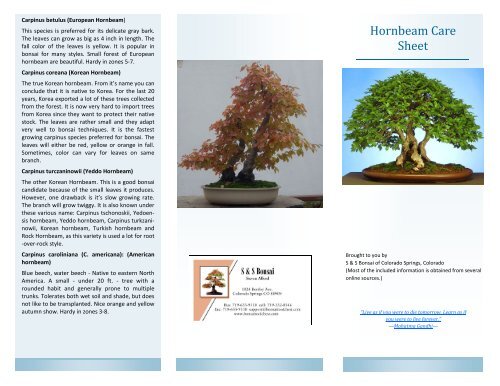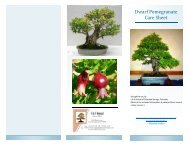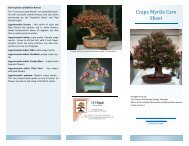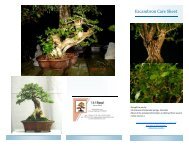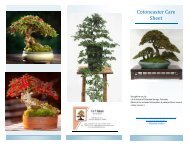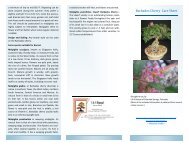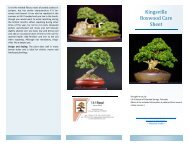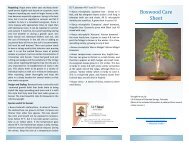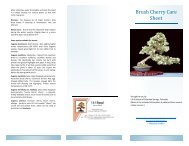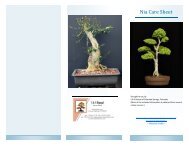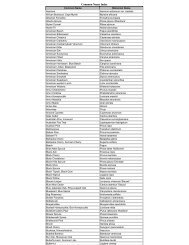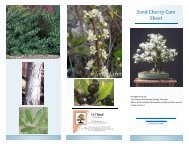Create successful ePaper yourself
Turn your PDF publications into a flip-book with our unique Google optimized e-Paper software.
Carpinus betulus (European <strong>Hornbeam</strong>)This species is preferred for its delicate gray bark.The leaves can grow as big as 4 inch in length. Thefall color of the leaves is yellow. It is popular inbonsai for many styles. Small forest of Europeanhornbeam are beautiful. Hardy in zones 5-7.Carpinus coreana (Korean <strong>Hornbeam</strong>)The true Korean hornbeam. From it’s name you canconclude that it is native to Korea. For the last 20years, Korea exported a lot of these trees collectedfrom the forest. It is now very hard to import treesfrom Korea since they want to protect their nativestock. The leaves are rather small and they adaptvery well to bonsai techniques. It is the fastestgrowing carpinus species preferred for bonsai. Theleaves will either be red, yellow or orange in fall.Sometimes, color can vary for leaves on samebranch.Carpinus turczaninowii (Yeddo <strong>Hornbeam</strong>)The other Korean <strong>Hornbeam</strong>. This is a good bonsaicandidate because of the small leaves it produces.However, one drawback is it’s slow growing rate.The branch will grow twiggy. It is also known underthese various name: Carpinus tschonoskii, Yedoensishornbeam, Yeddo hornbeam, Carpinus turkzaninowii,Korean hornbeam, Turkish hornbeam andRock <strong>Hornbeam</strong>, as this variety is used a lot for root-over-rock style.Carpinus caroliniana (C. americana): (Americanhornbeam)Blue beech, water beech - Native to eastern NorthAmerica. A small - under 20 ft. - tree with arounded habit and generally prone to multipletrunks. Tolerates both wet soil and shade, but doesnot like to be transplanted. Nice orange and yellowautumn show. Hardy in zones 3-8.<strong>Hornbeam</strong> <strong>Care</strong><strong>Sheet</strong>Brought to you byS & S Bonsai of Colorado Springs, Colorado(Most of the included information is obtained from severalonline sources.)“Live as if you were to die tomorrow. Learn as ifyou were to live forever.”—Mahatma Gandhi—
The <strong>Hornbeam</strong>(Carpinus sp. )General Information: <strong>Hornbeam</strong> bonsai come in avariety of species. From the Betulaceae family oftrees, this deciduous species is gracious with lightgreen foliage and a smooth, muscle-like, grey coloredbark. It is reportedly difficult to transplantfrom a field nursery.Ironwood is a common name for hornbeam. Thename ironwood comes from the ancient timeswhen they used carpinus wood to build ships.During spring, it produces wind-pollinated pendulouscatkins flowers. <strong>Hornbeam</strong> is monoecious,meaning the male and female flowers are on separatecatkins, but on the same tree.In general, the hornbeam is a slow growing tree.The leaves will turn yellow, orange and red in thefall and will turn brown when dry. The brownleaves will often stay attached in the winter season.Six species are popular as bonsai. Two of them areknown as Korean hornbeam while one is known asthe European <strong>Hornbeam</strong> or Common <strong>Hornbeam</strong>.Two are Japanese <strong>Hornbeam</strong> and one is the American<strong>Hornbeam</strong>.CARETemperature: Hardiness Zones: 5-8. Needs to beprotected from hot summer sun and freezing temperaturesduring winter.Lighting: Full Sun to semi-shade. In hot summermonths move to a semi-shaded position out ofdirect sunlight and wind, to avoid the leafs scorchingat the edges and tips. The carpinus trees arevery forgiving about light conditions. They willgrow attractive and open with shaded light. Theywill however grow very dense in full sun. In spring,young shoots are best protected with partialshade. The rest of the growing season, full sun ispreferred.Watering: Likes moist but well drained soil. It isimportant not to let the soil dry out inbetweenwaterings. Moderate watering is needed but in thepeak of the summer growing season it will requiremore and constant watering.Fertilizing: Feeding instructions vary greatly. Thisauthor prefers a weekly feeding for the first monthafter bud-burst, switching to every two weeksthereafter until summer. And then to stop feedingfor a month long break in August. Then back to twoweek feeding through the rest of the growing season,stopping completely in the fall. Ordinary plantfood at half strength is fine, as is bonsai fertilizer.Use an organic fertilizer, to avoid salt imbalances inthe soil. Inorganic fertilizers can lead to excessivefeeding resulting in thickened branches and largeleaves. Do not feed for two months after repotting.C. laxiflora may experience branch die-back if underfed.Pruning / Training: Carpinus can be wired fromspring to autumn - some bark protection may beneeded, but the hornbeam is fairly sturdy for adeciduous tree. The Korean <strong>Hornbeam</strong> with itstwiggy branches does not normally need to bewired, you can achieve most shaping with timelypruning, as it responds very well to pruning. If required,younger branches can be shaped with wiringbetween spring and summer but watch out forscaring as the branches can grow quite quickly duringthis period. Older branches are best shapedwith anchoring. It accepts repeated pruning withquickly healing scars. Prune back to the first pair ofleaves on new shoots that have about 5-6 leafs ona stem. The best times for minor pruning are earlyspring and after flowering. Major developmentalpruning should be done in late winter, before budburst; before sap starts rising as the hornbeamsbleed quite profusely. There is strong apical growthof the upper part of the tree, so it may be necessaryto cut back radically at the apex, but prune thelower portions of the tree conservatively, especiallywith the Japanese species, in order to check itsrapid apical growth. Defoliation to reduce leaf sizeis possible, but will inhibit flowering and fruiting.As it ages branches die, complicating managementas a bonsai. As the tree ages, branches may dieback for no discernable reason.Insects / Pests: Usually problem free. Sometimescould be troubled by leaf spot, leaf miner, spidermites, canker, powdery mildew and dieback. Leafspots are not serious so control measures are usuallynot needed. Canker, caused by several fungi,causes infected branches to dieback and entiretrees die if the trunk is infected and girdled.Propagation: Fresh seed in fall is best - sow immediatelyin an outdoors seedbed as soon as it isripe. Otherwise, seed must be cold treated andplanted in late winter. Seed which has been driedmay need up to a year to germinate. If collectedwhilst still 'green' it should germinate in the followingspring. Move to pots as soon as largeenough to handle and grow in a sheltered locationfor the first couple of winters. It is difficult to getviable seed from C. japonica, as there is little overlapin flowering time between the male and femaleflowers. May also be propagated by cuttings.Carpinus cuttings are easier to root in early springfrom juvenile tree shoot. Carpinus cuttings have apoor success rate. The correct time to do air layeringis in the spring as the buds are ready toopen. Use ring barking for best effect. Grafting isalso used.Repotting: Every 2-3 years in early spring. Theycan be root pruned quite vigorously, with between30%-40% of root ball edges being cut back if required.Prefers a deep pot. <strong>Hornbeam</strong>s aren'tfussy about the compost they grow in but the bestsoil to use is 2 parts Turface mixed with 1 partgeneral purpose Bonsai compost or pumice.Design and Styling: Formal upright; Informal Upright;Slanting; Cascade; Semi-cascade; Broom;Twin-trunk and Group planting . Excellent tree forstyles with exposed roots.


